Richard Meyer
January 30th, 2023 by Athletic Mentors StaffTina Meyer
September 22nd, 2022 by Athletic Mentors StaffStacy Zirkle
June 28th, 2022 by Athletic Mentors StaffPhil Schiller
June 28th, 2022 by Athletic Mentors StaffThe Divide – Gravel Road Race
August 24th, 2021 by JoAnn CransonBy: Christina Vipond
The Divide began in 2015 by Jeff Harding and Don Passenger as a fundraiser for Manton Public School’s Cross Country and track teams. It is held the last Sunday of July and is part of the Michigan Gravel Road Series.
The Divide offers something for all gravel enthusiasts with 3 route options: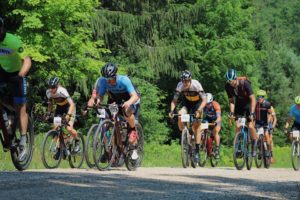
- 19 miles with 1330 feet of elevation change
- 34 miles with 1987 feet of elevation change
- 50 miles with 2292 feet of elevation change.
There is an outer loop that the 34 mile course completes one time and the 50 mile racers get to experience it twice. The outer lap is ridden in opposite directions every year to vary the terrain profile. All routes begin and end on paved roads in Manton, Michigan. Around the 3 mile mark, these roads turn to mostly hard packed gravel with “a little two-track” and “a little sand” for a scenic ride on the outskirts of the Manistee National Forest.
The Divide is a great race for gravel, mountain and fat tire bikes. As with so many other races, The Divide will leave racers wondering if they are riding the right size tire for the course.
Jeff, Don and their volunteers (including the cross country and track teams) were top notch with ice cold drinks and freeze pops at all aid stations. The course was well marked with signs and volunteers were stationed throughout the course to make sure racers stayed on course. Photographers volunteered their time and posted over 1000 photos that racers could share for free.
This year’s race took place on Sunday, July 25th. Jeff and Don, as always, did a great job of posting on The Divide’s Facebook to keep racers up to date. A post on July 22nd, updated the course conditions. It was reported that the roads were recently brined and the outer loop was rolling “faster than ever”. Then the news about the infamous Gilbert Corners, a section of sandy two-track that keeps racers guessing about their bike choice. The 19 milers could expect some sand at the bottom of the downhills. The 34 milers would ride this 3-4 mile section mostly uphill on their way back into town. The 50 milers would get to ride this section both out and back. There will be some “sketchy downhills” on the way out and “on the way back the sand at the bottom of those downhills will zap your legs before the punchy uphills challenge your will power”.  There was a July 24th update post reporting the rain had made the washouts on Gilbert Corners a little bigger. “Caution Ahead” signs were put out throughout the course with a Facebook posted warning “when you see a caution sign, we mean it!”
There was a July 24th update post reporting the rain had made the washouts on Gilbert Corners a little bigger. “Caution Ahead” signs were put out throughout the course with a Facebook posted warning “when you see a caution sign, we mean it!”
Athletic Mentors represented well in the race with athletes using a variety of tire sizes.
- Jared Dunham took 3rd overall in the 50 mile race. He rode 42cc but felt he would have been fine on 40cc tires. Jared said he feels like the sand made a few of the hills more challenging but you don’t need a big tire to ride the course. He further stated that “The Divide may be 50 miles but it’s probably the most memorable 50 mile race course I’ve done so far.” He thought it was a good race, very hilly with some sand thrown in.
- Terry Ritter took top spot in the 50+ class for the 50 mile on 36cc tires. He felt the course conditions were excellent; right direction and plenty of heavy rain the day before.
- Hunter Post took 1st in his age group and 4th overall in the 50 mile race, racing 40 cc tires. He also felt the rain helped firm up the sand, but the depth was still energy draining. Particularly on the 2nd lap, once the sand was chewed up by other riders. Hunter liked the direction of this year’s outer loop as well.
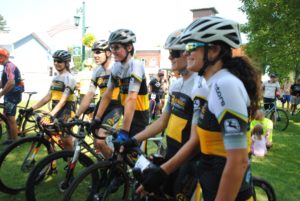
- Melanie Post took 1st in her age group for the 34 mile race. Melanie raced on 40 cc tires and stated she also liked the route this year. “The sandy climbs were definitely the most challenging part of the course, aside from just the elevation gain in general. The course was very well marked with great volunteers as always.”
- I raced the 50 mile route on 36cc tires and finished 2nd overall for women. Choosing lines on the edge of the two-tracks was helpful but I still did my fair share of walking some of the deeper sand. The main gravel roads were in great condition.
The Divide really does have something for everyone with 3 options for miles, challenging climbs, fun and memorable sections of sand, and beautiful scenery on quiet gravel roads. It is a great fundraiser with all proceeds going to Manton’s cross country and track teams. Hope to see YOU there next year!!
Rebuilding After Injury
March 14th, 2021 by JoAnn CransonBy: Christina Vipond
The risk of injury is common for athletes and many who mountain bike have their fair share of stories to tell. I learned so much about cycling and racing in my rookie year with a few minor injuries to talk about. The season ended with a fun ride of the Iceman No Cometh, the nicest weather ever for the non-event The next day, I was mountain biking with a friend when my back wheel slid out on dry leaves and down I went. It should have been a non-incident, unfortunately, my left arm was extended when I landed and I heard bones breaking. The doctor from ER reported the X-Rays showed a shattered head of the humerus in my shoulder. The doctor even suggested that given the extent of the injury I might need a total shoulder replacement. Although the news was devastating, I tried to be optimistic, telling myself “at least it is the first day of the off season.”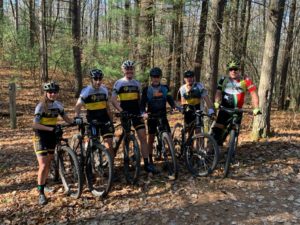
A follow up appointment with a shoulder specialist and sports medicine doctor gave a more positive outlook. The shoulder was not ‘shattered” as the ER doctor described, but the head and upper shaft of the humerus was broken in three places. Surgery took place five days after the break. During the surgery it was revealed that the rotator cuff had been torn and where it attached to the humerus, that piece of bone had been broken. A plate and 11 screws were used to put the bone back together and the rotator cuff was repaired. The doctor was optimistic and said I could be back on the trainer in three weeks. Even with the optimism, shoulder injuries are known to take a long time to heal and I knew that race season started in just over 4 months.
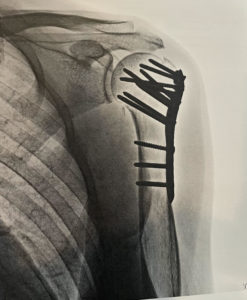 Recovery has different stages and doesn’t always follow a linear path. Proper nutrition is important for athletes and even more so during recovery. I immediately received advice on the best nutritional approach for healing the bone. A diet high in protein,Vitamins C and D, magnesium, calcium and potassium was recommended. As for the arm, the first three weeks focused on resting with as little movement as possible. A sling kept stabilized, great for healing, not so great for everyday tasks that had been taken for granted. Sleeping was difficult due to the sling and fear of rolling onto the shoulder.
Recovery has different stages and doesn’t always follow a linear path. Proper nutrition is important for athletes and even more so during recovery. I immediately received advice on the best nutritional approach for healing the bone. A diet high in protein,Vitamins C and D, magnesium, calcium and potassium was recommended. As for the arm, the first three weeks focused on resting with as little movement as possible. A sling kept stabilized, great for healing, not so great for everyday tasks that had been taken for granted. Sleeping was difficult due to the sling and fear of rolling onto the shoulder.
At the three week mark, I was finally able to get on the trainer. I had been wearing tank tops because they were easy to get on and off. Sports bras were impossible to put on and even harder to take off so I bought front closure sports bras. That was still a challenge with one arm. I learned from watching YouTube videos that I could hold one side with a door jamb while using my right hand to fasten it. I had to get used to wearing glasses while on the trainer because I couldn’t put contacts in. Even putting the heart rate monitor on required a couple of tricks (the door jamb trick worked well for the strap too). Training rides started very easy and with short durations but it was nice to return to a form of normalcy.
Four weeks after surgery I was able to start taking the sling off, begin range of motion exercises and gradually add weight training. This was exciting but also frustrating. Atrophy happens so fast, and rebuilding strength happens so slow. It was nice to have daily encouragement from teammates during this stage. Some days felt like huge gains had been made, but others felt like three steps backwards had been taken. I continued to be diligent with nutrition, arm exercises and increased time and effort on the trainer.
Two months after the surgery, I saw the surgeon again. He took X-Rays and checked the strength and range of motion of the arm. He then said,“I have one question for you, what is your secret to healing so quickly?” I told him, “It’s easy. Proper nutrition, treating rehabilitation like training, and support from friends.” Maybe said differently, I never stopped thinking or acting like an athlete in training. The arm isn’t 100 percent yet but it is strong enough to start the season. I have come to recognize the road back as a journey. While I am not at the final destination yet, I am within striking distance. I will use this season to get the rest of the way there.
Transitioning from Athletic to an Athlete
August 11th, 2020 by JoAnn CransonBy: Christina Vipond
It still seems surreal to me that I am a sponsored athlete for the first time in my life at the age of 48. When I tell family or friends, the response is usually something like, “I’m not surprised, you have always been athletic”. I respond by saying “but now I’m an athlete!” This is usually followed with a look that says “what’s the difference?”
Great question, what is the difference? Do the definitions give a simple answer?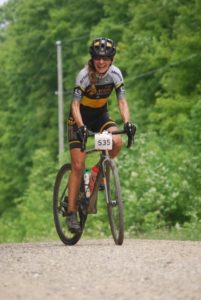
Athletic is an adjective meaning physically strong, fit and active.
Athlete is a noun meaning a person who is proficient in sports and other forms of physical exercise.
Not really an answer there.
I played softball in high school. As an adult, I played rugby and currently spend the winter season playing hockey. These sports do require some athletic skills, there is definitely some level of physical fitness required to play 3 periods of ice hockey, but I don’t train or practice. I show up at the ice rink one time a week. I competed in a body-building show in 2010. This did require intense training and a strict diet but I didn’t think of myself as an athlete while doing this. Body building was mostly about sticking to a rigid diet and lifting weights for a couple of hours every day.
So back to the question, what is it about racing for Team Athletic Mentors that makes a person go from athletic to an athlete?
One obvious answer is that I have a contract. I committed to fulfilling certain criteria and wearing the team kit that has the names of team sponsors. I don’t have to sign a contract to play hockey, I show up when games are scheduled and if I can’t make it one night, I let the captain know so she can get a sub. Getting a sub is not an option when I sign a contract.
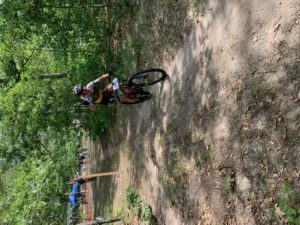 The training is specific as an athlete. I learned with this training where my strengths were and how many weaknesses I needed to improve. I quickly learned how my body felt and reacted to workouts. As a club rider, I would ride everyday so when I was told I had to take days off to rest, I bulked and proudly stated “I don’t need days off”. It didn’t take long before I was grateful for a rest day. I had no idea my legs would be so tired when training as an athlete.
The training is specific as an athlete. I learned with this training where my strengths were and how many weaknesses I needed to improve. I quickly learned how my body felt and reacted to workouts. As a club rider, I would ride everyday so when I was told I had to take days off to rest, I bulked and proudly stated “I don’t need days off”. It didn’t take long before I was grateful for a rest day. I had no idea my legs would be so tired when training as an athlete.
Nutrition is also different as an athlete.. I had to learn what and when to eat food that allowed me to maintain energy, repair muscles, and keep an ideal weight for racing. The diet for body-building was strict but it had a specific purpose: decrease fat, increase muscle mass. This diet was extreme and could only be maintained for a short time. The diet as an athlete, and one who may be doing hours of riding on any given day, has to be sustainable during the training and racing season, which is the entire year.
I also had to be pushed out of my comfort zone and learn the nuances of racing. Braking around corners was okay as a club rider. I didn’t have to ride with other cyclists right next to me. The thought of continuing to ride on single track while someone passed me never crossed my mind, nor did the thought I might actually pass someone on a trail.
How is being an athlete different than being athletic? Athletic means I can do certain physical tasks. Being an athlete requires so much more. The training and nutrition are specific to achieve maximum performance. The education is continuous. Being an athlete requires commitment, dedication, and perseverance. I am honored to be an athlete.
Pumping Iron: Strength Training for Endurance Runners
October 28th, 2019 by JoAnn CransonBy: Erin Young
“I’m a runner, why should I strength train?” I get this question often and honestly there is no single, easy answer. But I do believe there is a time for strength training in every athlete’s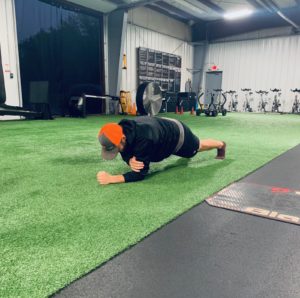 year. It will look different for every runner. It may be an off season activity while the snow flies, it could be three days a week up until the competition or just 20 minutes a day to work on core, balance or weaknesses.
year. It will look different for every runner. It may be an off season activity while the snow flies, it could be three days a week up until the competition or just 20 minutes a day to work on core, balance or weaknesses.
In the last decade, new research is showing that strength training can benefit many kinds of endurance runners–if the right types of it are done in the right doses. This newer research suggests that strength training can enhance endurance-running performance by improving running economy, delaying the onset of fatigue, improving maximal speed, and increasing anaerobic capacity.
When broken down to its components, strength training temporarily overloads the neuromuscular system, which allows for an improved ability to recruit individual muscular units, an increase in muscle-firing frequency, increased muscle-tendon stiffness (allowing you to have more stored energy with each step), and improved muscular coordination over time. These are all minor physiological changes but together and over time equal running-economy improvement which allows you to run a given pace with a little less effort.
“But Won’t I Bulk Up?”: Addressing Strength-Training Fears
The most common concern I hear from endurance runners is the fear of putting on bulk from strength training. Now there is something to be said for individual genetic predispositions, but science shows almost a complete lack of muscle growth with strength and endurance training–in correct dosing. Why is this? Muscle growth with concurrent strength and endurance training seems to be blocked on a molecular level.
As we’ve alluded to a couple times in this article so far, there appears to be a dosing ratio at play. When athletes maintain a 3:1 ratio in the number of endurance sessions to the number of strength sessions they perform, muscle growth doesn’t occur. So if an athlete wanted to gain mass while still getting some of the benefits of concurrent strength and endurance training, they would need to increase the number of strength sessions or decrease the number of endurance sessions.
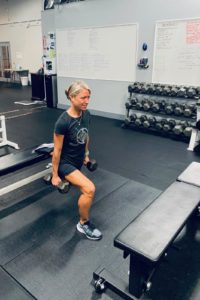 Strength Training and Injury Prevention
Strength Training and Injury Prevention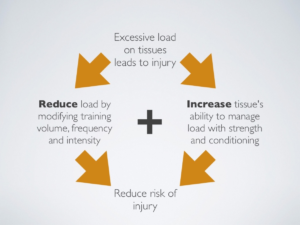
A lot of athletes will tell you that strength training helps them feel more durable. There is research suggesting that traditional strength training can reduce sports injuries significantly. This is done by increasing your tissue’s ability to manage load while modifying endurance-training volume and frequency.
For example, one study that replaced 30% of an athlete’s weekly running volume with strength training found that athletes remained injury free while improving their five-kilometer performances. Additionally, hard strength training has positive effects on circulating levels of testosterone and human growth hormone which can help the body repair muscular damage at faster rates post-hard-endurance and post-hard-strength-training efforts.
Maybe that’s what durability feels like? That is, creating enough physical change to more than manage your niggles and instead create more significant physiological adaptations that keep fatigue at bay longer and hold your form together longer because you increased your running economy. That is, you became physically stronger. I’m not certain we will ever have a perfect metric to measure durability, but if being stronger keeps you on the trail more consistently, that might be as close as we get to an answer.
Strength Training for the Aging Endurance Runner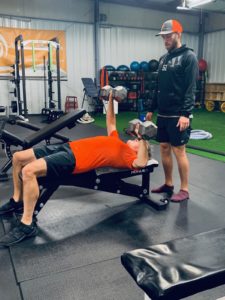
When it comes to aging and declining endurance-running performance, naturally decreasing muscle mass seems to be the main culprit. This is because there is a direct link between the age-related decrease in VO2max and muscle-mass loss. This age-related muscle-mass loss starts somewhere just north of age 40 and accelerates rapidly after 70. Between the ages of 40 and 80 and with no intervention, you should expect to naturally lose approximately 40% of your muscle tissue. Also note that muscle loss in the aging woman appears to happen at a slightly increased rate than men.
What this means for our aging athletes is that strength training to maintain and build muscle mass is incredibly important. The current, best treatment for muscle loss is strength training. The general recommendation is that if you are over the age of 40 and not currently strength training, we should probably change that.
Need help with a strength training regimine for your next endurance event? Fall and winter is a great time to reduce your running load and hit the gym! Visit www.athleticmentors.com to see how we can make you better, faster and stronger on the trail!
Iceman Cometh Yet Again
October 11th, 2019 by Kaitlyn Patterson–By Kaitlyn Patterson, Team Athletic Mentors cyclist
The first Saturday in November is a date circled in red for the past five years and stands as my favorite 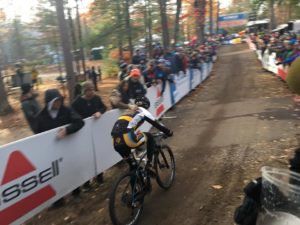 bike race/party. Thinking about riding into Timber Ridge into the celebration zone usually gives me goosebumps all year.
bike race/party. Thinking about riding into Timber Ridge into the celebration zone usually gives me goosebumps all year.
I would love to say that every year I carefully crafted my training to arrive at Iceman as fit and fresh as possible, with my equipment dialed and mentally ready. In reality, most years my build-up has been less than perfect and the race itself has felt like pulling a rabbit out of a hat, with me more surprised than the crowd about the result. Starting medical school in 2016 has been an awesome ride but also a complicating factor in bike racing, mostly in the unpredictability and uncertainty of the process. I didn’t necessarily expect how unpredictable the schedules, clinical demands, testing schedules, and travel would be when I started, but this has been just as challenging as the material itself. However, exercise has always been my way to recharge which is why I prioritized it, even if not in the form of structured training on the bike. Every year certainly brought its own different challenges and it has been simply good timing that the fall was possible to spend more dedicated time on the bike and the season that I would get the itch to race.
Now in my final year of medical school, this season is turning out similar. I have spent the last two months living out of a suitcase rotating at Mayo Clinic and the University of Utah and will begin interviewing for Physical Medicine and Rehabilitation residencies in the coming weeks. Although I didn’t plan to race given my interview schedule this fall, it looks like I may be able to line up in November. My summer and fall have been filled with plenty of explorations in new places by foot and bike, but certainly not structured training. However, Iceman is calling yet again and I will see what I can put together this year. The last several years have created some pretty high expectations but this year I’m just hoping to be able to stay in the mix.
In reflection of the past five years of Iceman and preparation of this year, I wanted to add to the Iceman banter. Over the following couple weeks, I will share a series of blogs sharing my thoughts and experiences on bikes, training and strategy for the big dance. Happy Iceman season!
41 Reasons to Trail Run
October 4th, 2019 by JoAnn CransonBy: Erin Young
Runners, just like everyone else, are often set in their ways. We like the shoe brand that we have been wearing for years and will never switch. We have our favorite routes, which we run religiously at least 3 times a week. And we are hesitant to leave the comfort of the road to try out something new, like trail running.
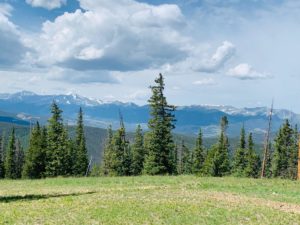 We have excuses like, It’s too hard on your body, I’ll get lost, It’s dangerous, the monsters in the woods will eat me… Well, I’m writing this to let you know that is is actually less stressful on your body, you can run out and back to avoid getting lost or download one of the nifty apps (Alltrails) for your phone, and I promise you that people are more dangerous than wildlife… and monsters.
We have excuses like, It’s too hard on your body, I’ll get lost, It’s dangerous, the monsters in the woods will eat me… Well, I’m writing this to let you know that is is actually less stressful on your body, you can run out and back to avoid getting lost or download one of the nifty apps (Alltrails) for your phone, and I promise you that people are more dangerous than wildlife… and monsters.
I left the road years ago. Occasionally I have to run a little road to get to the dirt, but the road is much less adventurous to me after the years spent on trail. I love helping others find the adventure and beauty of the trails. It has made me a stronger runner, physically and mentally. But here are 41 other reasons to run trail as soon as tomorrow…
1) You won’t find traffic lights on the trail. There is nothing worse than stopping every block to wait for the light to change. Avoid those pesky lights all together by hitting the trails.
2) Wildlife on the road usually comes in the form of roadkill, but on the trail, you are one with nature and all the wildlife that comes with it. But remember they are more afraid of you than you are them!
3) Trail running is easier on the knees than pounding the pavement. The more giving trail will help prevent injury to knees and joints.
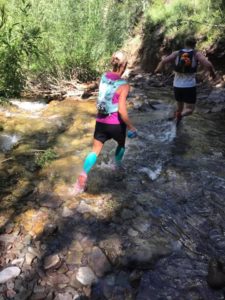 4) Trail running strengthens ankles, also helping to strengthen the muscles that support your feet and legs.
4) Trail running strengthens ankles, also helping to strengthen the muscles that support your feet and legs.
5) You aren’t going to get hit by a car on the trail, so while other dangers might be of concern, traffic most certainly is not.
6) Balance is a big issue for many of us. When trail running we are forced to adjust our balance with every stride. Over time that practice will improve our balance which helps us not only in the present, but as we age.
7) It is hard to get bored on a run, when you are constantly paying attention to your footing and your surroundings are so beautiful.
8) Trail running lets you experience the seasons in the rugged way nature intended.
9) Roads are designed so that hills are not too steep or sudden. Trails are not. You can run killer hill workouts on the trail that could never be done on the road.
10) Some of the best running races in the world are run on trails. By getting into trail running, you open yourself up to a whole new world of races both locally and elsewhere.
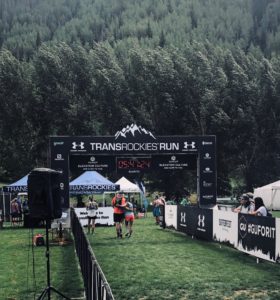 11) By running the singletrack, you gain immediate membership into a new running subculture. The trail running community is very friendly, I promise.
11) By running the singletrack, you gain immediate membership into a new running subculture. The trail running community is very friendly, I promise.
12) If you want to run ultramarathons, you better start thinking about trail running. Most ultras are run on trail.
13) Trail running works a variety of muscles in the legs and back, giving you a more well-rounded workout than running on smooth pavement. This is important for strength and helps prevent injuries.
14) Trails can be found just about anywhere. Check out the AllTrails app for wherever you live and travel.
15) Every new location provides a distinct trail experience. The type, elevation, and views from one trail can be completely different than another.
16) When running you can cover much more ground than hiking. Turn that 5 mile day hike through the woods into a 10 mile trail run in the same amount of time!
17) Nothing screams adventure like a trip deep into the wild wilderness.
18) Slow trail running builds crazy amounts of muscle that road running just can’t do. When you hit the roads after a few trail outings, you’ll notice that new strength speed.
19) People, bikes, and strollers all crowd the sidewalks you are trying to run down. Get away from the crowds by hitting the trail.
20) Getting dirty is a lot of fun, and really easy to do when trail running. Think of it as being a kid again.
21) You can take a lot cooler pictures from a mountain peak or river bank than you can from a city sidewalk.
22) Trail running can be turned into an entire vacation by camping out on the trail and running during the day.
23) Need a boost to your self-esteem? Start telling people you are trail runner. They will think you are a badass, trust me.
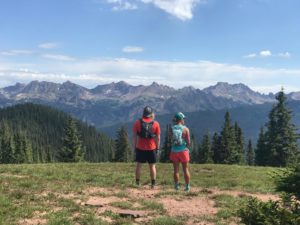 24) Everyone likes to have an excuse to run slow. You will naturally run slower on trails than the road, so now you don’t have to hide it!
24) Everyone likes to have an excuse to run slow. You will naturally run slower on trails than the road, so now you don’t have to hide it!
25) Training at a higher elevation makes running at low elevations easier. Trails will often lead you up a mountain or along a ridge, providing great opportunities for running at elevation.
26) When you read blogs like irunfar.com and atrailrunnersblog.com, you will relate.
27) Being a trail runner doesn’t mean you can’t still be a road runner.
28) You burn 10% more calories trail running than you do on regular road running.
29) Many runners rank solitude as one of their favorite parts about running. On the right trail, you will feel like you are the only person in the world. But there are often great opportunities to make life long trail friends!
30) Trail hills can be tough, but no one in the trail running community cares if you throw your hands on your knees and power-hike your way up the hill. In fact, it is expected!
31) Trying out a new sport means trying out cool new gear!
32) It is really easy to get lost when trail running (in your thoughts, hopefully not on the trail). And in my opinion, so what if you get lost on the trail. It might be the best adventure you’ve had in years. These days, it seems far more difficult to get lost than it is to find your way home.
33) Adrenaline keeps a lot of runners going when they are tired. By moving your run to a more extreme location (a trail), that adrenaline keeps pumping.
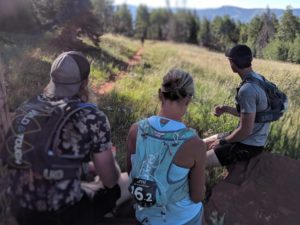 34) When you need a rest, it’s a lot more pleasant to rest by a creek, under a tree, or on a mountain peak than on a street corner.
34) When you need a rest, it’s a lot more pleasant to rest by a creek, under a tree, or on a mountain peak than on a street corner.
35) You’ll begin to feel like a Tarahumara Indian. See Born to Run, required reading for all trail runners.
36) It is easy to turn a short run into an all-day trek through the woods. Switch between hiking and running if you want to spend more time on the trail.
37) After following a few simple steps, even the indoorsman can feel prepared. There is nothing you’ll need that a handheld water bottle or hydration pack won’t carry.
38) The softer surface will help keep your feet healthy as you break in those new minimalist kicks.
39) Hikers think you are crazy, sexy, cool, when you speed by them.
40) Right now you probably get weird looks when you break out the headlamp for early morning or late evening road runs. No one out on the trail at that time of day/night would think twice about the glowing lantern coming from your forehead.
41) Trail scars are impressive.
That might seem like a lot of reasons, and there are so many more. If you ever need a guide, I’m your girl. Coaching endurance and trail runners is my favorite thing to do, besides running trails! erin@athleticmentors.com










